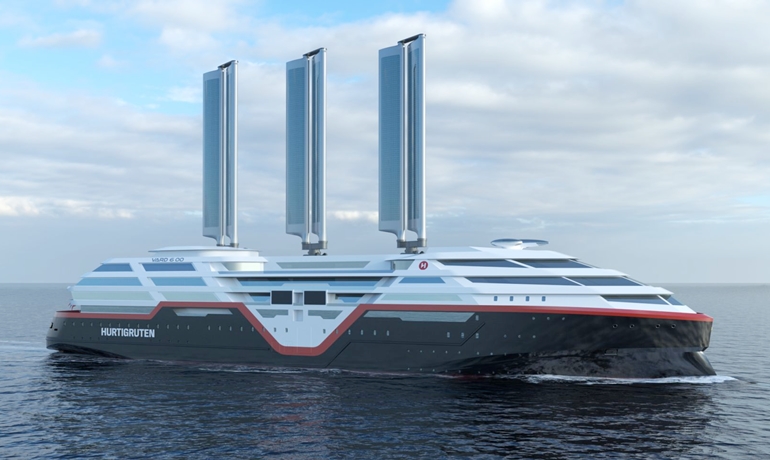
Hurtigruten SeaZero, the new design © VARD Design
Hurtigruten’s SeaZero project design moves forward
CruiseHurtigruten and VARD have revealed the design of their second version of the future coastal cruising ship. With the help of large batteries, sails, and other innovative solutions, this ship will be able to sail entirely emission-free during normal operation along the Norwegian coast. They estimate that energy consumption could be reduced by 40-50 percent.
The design has now taken an important step forward, and the second version is now even more advanced. It was developed by VARD, one of Hurtigruten’s key partners in the SeaZero-project, and integrates several innovative solutions created in collaboration with partners from the Norwegian maritime industry.
Calculations show that the ship will use about 40-50 percent less energy than today's ships, which makes it possible to operate primarily on batteries as the main energy source.
One of the most exciting elements is the sails, which can be raised and lowered as needed. Preliminary estimates indicate that the sails could reduce energy consumption by around 10 percent over time. Additionally, solar panels will contribute another 2-3 percent in energy savings.
The type of sail being investigated is called OceanWings. These French-developed sails are already in use on the cargo ship CANOPEE.
“We still see significant energy savings from having retractable sails with solar panels, but this requires thorough studies, including model tests to be conducted in the coming months. We have also changed the sail type to a more mature design already in use on cargo ships”, Gerry Larsson-Fedde, Chief Operating Officer of Hurtigruten.
Technical innovations
The ship is planned with contra-rotating propellers as the main propulsion, and the batteries will have a capacity of around 60 MWh. Two retractable thrusters at the stern will ensure optimal manoeuvring during port operations and provide increased safety through redundancy.
- The central part of the project is to reduce energy consumption. The goal is to use significantly less energy than today's ships, which requires innovative solutions, says Larsson-Fedde.
Another measure is air lubrication of the hull, where air bubbles are pumped beneath the hull to reduce drag. This can provide energy savings of 5-10 percent. Combined with modern hull design, advanced anti-fouling coatings, and regular hull cleaning, water resistance can be significantly reduced.
Preliminary results also show that better ventilation and insulation systems, as well as advanced energy management, can lead to significant energy savings.
So-called “smart cabins” will allow guests to control their own energy usage. Through an app and a screen in the cabin, guests can control heating and ventilation while also seeing how much energy is being used. This will increase guests' awareness of sustainability.
- We are already testing advanced sensors in these cabins, and in the near future, we will conduct full-scale tests with guests onboard, Larsson-Fedde concludes.
Developed with VARD and the Norwegian maritime industry, key innovations include:
OceanWings sails: Could reduce energy consumption by 10%.
Solar Panels: Adding an extra 2-3% in energy savings.
Air lubrication: Cutting drag by 5-10%.
Smart cabins: Allowing guests to monitor and manage their own energy use via an app.
The SeaZero ship is modelled at 135 metres long, with 270 cabins that hold 500 guests and 99 crew. The new ship will also have a significant cargo hold and transport cars.
Hurtigruten in deep debts
On a separate note, the Hurtigruten group's own annual accounts show a total debt of over NOK 26 billion, while the total assets ??of the company are NOK 16 billion. In the second quarter of 2024, Hurtigruten Group made a loss before taxes of NOK 880 million.
© Shippax

The old design with the sails fully extended © VARD Design
Oct 10 2024
Most read
Armas Trasmediterránea to Operate Canary Islands–Cádiz Public Interest Line for Another Year
Jun 27 2025





















